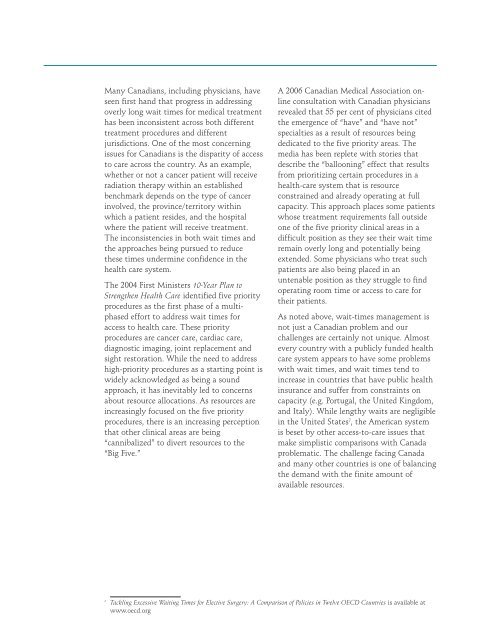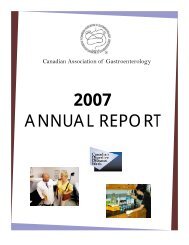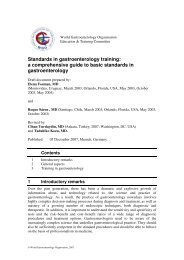Wait Times A Medical Liability Perspective - The Canadian ...
Wait Times A Medical Liability Perspective - The Canadian ...
Wait Times A Medical Liability Perspective - The Canadian ...
You also want an ePaper? Increase the reach of your titles
YUMPU automatically turns print PDFs into web optimized ePapers that Google loves.
Many <strong>Canadian</strong>s, including physicians, haveseen first hand that progress in addressingoverly long wait times for medical treatmenthas been inconsistent across both differenttreatment procedures and differentjurisdictions. One of the most concerningissues for <strong>Canadian</strong>s is the disparity of accessto care across the country. As an example,whether or not a cancer patient will receiveradiation therapy within an establishedbenchmark depends on the type of cancerinvolved, the province/territory withinwhich a patient resides, and the hospitalwhere the patient will receive treatment.<strong>The</strong> inconsistencies in both wait times andthe approaches being pursued to reducethese times undermine confidence in thehealth care system.<strong>The</strong> 2004 First Ministers 10-Year Plan toStrengthen Health Care identified five priorityprocedures as the first phase of a multiphasedeffort to address wait times foraccess to health care. <strong>The</strong>se priorityprocedures are cancer care, cardiac care,diagnostic imaging, joint replacement andsight restoration. While the need to addresshigh-priority procedures as a starting point iswidely acknowledged as being a soundapproach, it has inevitably led to concernsabout resource allocations. As resources areincreasingly focused on the five priorityprocedures, there is an increasing perceptionthat other clinical areas are being“cannibalized” to divert resources to the“Big Five.”A 2006 <strong>Canadian</strong> <strong>Medical</strong> Association onlineconsultation with <strong>Canadian</strong> physiciansrevealed that 55 per cent of physicians citedthe emergence of “have” and “have not”specialties as a result of resources beingdedicated to the five priority areas. <strong>The</strong>media has been replete with stories thatdescribe the “ballooning” effect that resultsfrom prioritizing certain procedures in ahealth-care system that is resourceconstrained and already operating at fullcapacity. This approach places some patientswhose treatment requirements fall outsideone of the five priority clinical areas in adifficult position as they see their wait timeremain overly long and potentially beingextended. Some physicians who treat suchpatients are also being placed in anuntenable position as they struggle to findoperating room time or access to care fortheir patients.As noted above, wait-times management isnot just a <strong>Canadian</strong> problem and ourchallenges are certainly not unique. Almostevery country with a publicly funded healthcare system appears to have some problemswith wait times, and wait times tend toincrease in countries that have public healthinsurance and suffer from constraints oncapacity (e.g. Portugal, the United Kingdom,and Italy). While lengthy waits are negligiblein the United States 2 , the American systemis beset by other access-to-care issues thatmake simplistic comparisons with Canadaproblematic. <strong>The</strong> challenge facing Canadaand many other countries is one of balancingthe demand with the finite amount ofavailable resources.2Tackling Excessive <strong>Wait</strong>ing <strong>Times</strong> for Elective Surgery: A Comparison of Policies in Twelve OECD Countries is available atwww.oecd.org
















